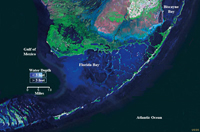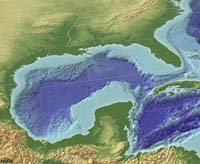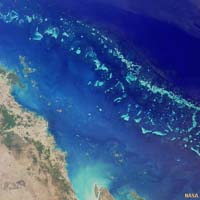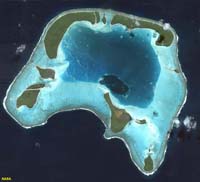6.18: Biogenous Sediments in the Marine Environment and Carbonate Reefs
- Page ID
- 10236
Biogenous Sediments in the Marine Environment
Biogenous sediments include sediments formed by accumulation of organic materials. Biogenous sediments are mostly composed of the remains of organisms (including skeletal remains of microplankton (both plants and animals), plant remains (wood, roots, and leaves) and remains of larger animals including shells of invertebrates, such as shells, coral fragments, and fish and other vertebrate teeth, bone, and scales, and fecal material left behind by any type of organism. Biogenous sediments may be partly mixed with lithogenous sediments (continental-derived sediments) in coastal regions, particularly where streams and rivers contribute sediments.
Bioaccumulation is the buildup of organic remains, such as deposits associated with coral reefs, shell or bone beds, and algae and ooze (calcareous and siliceous). On land bioaccumulation in swampy environments produces peat beds (with burial and time, peat eventually can be converted to coal). In many passive margin regions in tropical regions, carbonate sediments form and accumulate forming massive deposits along continental margins.
Carbonate Reefs
A reef is a general name for a ridge of jagged rock, coral, or sand just above or below the surface of the sea. A carbonate reef is one that is made of skeletal material composed of coral, coralline algae, and other carbonate skeletal material. Carbonate reefs are commonly called coral reefs but not all organisms that look like corals are actually corals—other organisms that create solid structure (branching or not) include coralline algae, bryozoans, sponges, stromatoporoids, and many other types of invertebrates). Figure 6.67 illustrates the variety of settings and features associated with carbonate depositional environments.

Carbonate (coral) reefs form in clear shallow, warm, tropical marine waters.
Over time, lime sediments are produced by biological activity in and around carbonate reefs. Carbonate reefs grow at rates of 10-30 feet per thousand years. Wave action and currents will erode and redistribute lime sediments offshore where it may accumulate, slowly building up massive carbonate platforms (becoming regions underlain by limestone). Examples of carbonate platform regions include the Bahamas, South Florida, and the Yucatan Peninsula (Figure 6.68 and 6-69).
The world's largest reef system is the reef tracts, islands, and tidal shoals associated with the Great Barrier Reef located along the east coast of Australia (Figure 6.70). The Great Barrier Reef is composed of over 2,900 individual carbonate reefs and about 900 islands stretching for over 1400 miles (2,300 km) along the northeast coast of Australia and encompassing about 133,000 square miles (344,400 km2). It is the largest feature of biological origin on Earth. Similar reef tracts have formed throughout geologic history in other locations around the world.






